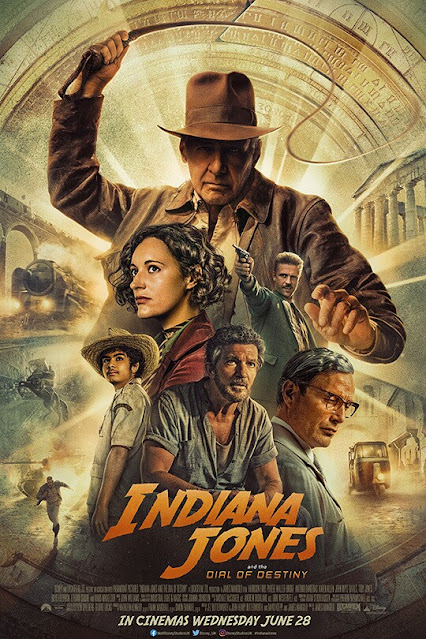INDIANA JONES AND THE DIAL OF DESTINY.
He's back. To paraphrase the Rolling Stones – could this be the last time?
The Indiana Jones franchise stretches over five films and nearly forty years. (Like the Stones themselves, it sometimes looks like Indy’s going to retire, but he never quite gets round to it). I reckon that’s probably unique in the annals of popular culture for a film series with the same stars – Dr Henry ‘Indiana’ Jones (the always agreeably rumpled Harrison Ford) and Marion Ravenwood (the wholesome but agreeably tough Karen Allen). Their on-off relationship gives an emotional heart to Indy’s adventures across the decades that, for the pensioners among us, has all the tensions and tenderness of a long and sometimes fraught relationship.
I love the way that, in their opening scenes, the last two films present the decade in which they’re set in unapologetically unsubtle ways – in Indiana Jones and the Kingdom of the Crystal Skull (2008) we had, in quick succession, rock and roll, Soviet communists, Area 51 (the long-rumoured repository of alien technology) and an atom bomb testing site. The film couldn’t have been more 1950s if it had a flashing neon sign above it screaming, ‘It’s 1957, folks! Really!’
Indiana Jones and the Dial of Destiny goes one better with an introductory sequence that reminds us why we all fell in love with Indy in the first place – principally, for beating up and killing Nazis in inventive ways in stunts that generally involve motor vehicles. Set in 1944, this features Indy at the age he was in his first film, Raiders of the Lost Ark (1981) i.e. with a de-aged Harrison Ford’s face grafted onto a stuntman’s body. That’s a very crude description, but the overall effect is seamless and incredibly convincing. It really makes you wonder what this technique has in store for the future of films and television. Perhaps we’ll see Sean Connery, who played Indy’s father, resurrected in years hence…
Following that innovative detour, it’s it’s-this-decade-guys! time again, and these scenes make the Crystal Skull’s 1950s motifs look positively subtle in comparison. It’s 1969 and there’s a New York parade featuring the Apollo 11 astronauts who landed on the moon, which just happens to coincide with an anti-Vietnam War demonstration, in which gunmen working for Nazi scientist Jurgen Voller (played by the reliably saturnine Mads Mikkelsen), who’s instrumental in America’s space program, chase Indy through the streets. This all ends in a jaw-droppingly unrealistic fashion, with 80-year-old-action-hero Jones riding a police horse through the New York City Subway, off platforms, into tunnels and narrowly avoiding trains. Impressively, the horse didn’t whinny with anxiety once.
Together with a pensioner who can floor villains twice his size with one punch, the opening sequences inform us that we’re in for the same tongue-in-cheek mix of cartoon violence and inventive stunt sequences as in the previous four films. And so we are, together with the obligatory sliver of mystical hokum, in this case the Archimedes Dial, which can locate fissures in time and navigate the operator through them.
The film concentrates its 154-minute length on action, and it has to be said that it’s at least one set-piece too long. Which is a shame, because audiences eat up good character interaction as much as they do spectacle. I think that was largely why Raiders of the Lost Ark was the highest-grossing film of 1981: audiences were as interested in Marion and Indy’s relationship and his feud with rival archaeologist Belloq (Paul Freeman), as they were in all the fun Nazi-bashing. On that score, stand out scenes for the actors in The Dial of Destiny are when Ford and Allen replay their famous romantic scene from the first film, this time with Marion as the one being comforted, and the curiously affecting death of the black CIA agent, Mason (Shaunette Renee Wilson), who finds out too late she’s been deceived by Voller. There should have been more scenes like that.
Indiana Jones and the Dial of Destiny is also a sign that Phoebe Waller-Bridge’s career trajectory is still very much on the up. She acquits herself well enough among all the mayhem as Helena, the posh daughter of Indy’s old friend Basil Shaw (Toby Jones), initially gone to the bad as a treasure hunter. Her stand-out scene, though, is when she misdirects the villains to the coordinates of the Dial, at the same time smuggling a stick of explosive to Indy. It’s a scene that makes good use of Phoebe’s comic talents, as well as her flair for convincing people that she’s less intelligent than her character really is.
For me, the biggest missed opportunity is when Indy ends up back in time during the Romans’ siege of Syracuse in 212-213 BC. Shot and worn out, he pleads with Helena to leave him there, as – movingly – he’s now living the history that he’s always loved through the distancing of archaeology. The scene is so poignantly and poetically played by Ford that I thought the producers were going to ‘do a No Time to Die’ and have Indy follow in James Bond’s celestial footsteps. OK, the reconciliation with Marion deliovers a feel-good ending, but having Indy turn out to be the skeleton in Archimedes’ coffin (it's wearing a wristwatch) would have been brave, dramatic and somehow fitting.
It’s worth noting that at the Cambridge Archaeology Unit, Indiana Jones is their pin-up and, on digs, the archaeologists have a tendency to wear very similar hats to Dr. Jones'. Whether or not The Dial of Destiny really is the final outing for one of the noblest icons of popular culture, Indiana Jones’ legacy is assured.




Comments
Post a Comment